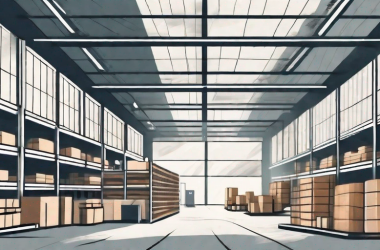The dynamics of warehousing and distribution centers are constantly evolving, driven by ever-changing market demands, technological advancements, and sustainability concerns. As we step into 2024, it becomes crucial to analyze and understand the trends that will shape the future of these critical sectors. In this article, we will explore the key trends and innovations that warehouse and distribution center operators must embrace to stay ahead of the competition.
Understanding the Future of Warehousing
The role of technology in warehousing cannot be overstated. With the rapid advancements in automation, artificial intelligence, and data analytics, warehouses are becoming smarter and more efficient. The integration of technology into everyday operations has revolutionized processes such as inventory management, order picking, and quality control.
The Role of Technology in Warehousing
One trend that will dominate the warehouse landscape in 2024 is the increasing use of robotics and automation. Robots are now capable of completing complex tasks, such as sorting and packing items, with incredible precision and speed. This not only reduces the reliance on human labor but also improves accuracy and reduces errors.
Additionally, the use of drones in warehousing is gaining traction. These unmanned aerial vehicles can be used to perform inventory checks, monitor stock levels, and even assist in order fulfillment. With their ability to navigate through narrow aisles and reach inaccessible areas, drones are proving to be a valuable asset in optimizing warehouse operations.
Furthermore, the adoption of advanced analytics and warehouse management systems enables real-time monitoring and optimization of operations. These systems provide valuable insights into inventory levels, demand patterns, and delivery schedules, allowing warehouse managers to make data-driven decisions and allocate resources effectively.
The Impact of E-commerce on Warehousing
E-commerce has significantly reshaped the warehousing landscape in recent years, and this trend is expected to continue in 2024. The rise of online shopping has led to greater expectations for fast and efficient order fulfillment. Warehouses must adapt to the challenges posed by e-commerce, such as processing a higher volume of smaller orders and managing returns.
Moreover, customer expectations for transparency and visibility have become paramount. Warehouses need to invest in technologies that enable real-time tracking of shipments and seamless communication with online platforms. The integration of e-commerce platforms with warehouse management systems will become crucial in ensuring customer satisfaction and retention.
Another emerging trend in e-commerce warehousing is the use of augmented reality (AR) technology. AR can be used to enhance order picking accuracy by providing warehouse workers with real-time visual cues and instructions. This technology not only improves efficiency but also reduces errors, ultimately leading to a better customer experience.
Sustainability Trends in Warehousing
The growing emphasis on sustainability and environmental responsibility is another significant trend in warehousing. As consumers become more environmentally conscious, they expect businesses to adopt greener practices across their entire supply chain.
In response to this, warehouses are adopting sustainable technologies and processes to reduce their carbon footprint. This includes the use of renewable energy sources, the implementation of energy-efficient lighting and heating systems, and the adoption of eco-friendly packaging materials.
Furthermore, some warehouses are exploring the concept of “green roofs” to maximize their environmental impact. Green roofs are covered with vegetation, which helps reduce stormwater runoff, improve air quality, and provide insulation, thereby reducing the energy consumption of the warehouse.
In conclusion, the future of warehousing is being shaped by advancements in technology, the impact of e-commerce, and the growing focus on sustainability. As warehouses continue to evolve, embracing these trends will be crucial for staying competitive in an ever-changing business landscape.
Innovations in Distribution Centers
Similar to warehousing, distribution centers are undergoing a transformation driven by technological advancements. These innovations are designed to streamline the flow of goods and improve the overall efficiency of the supply chain.
Automation and Robotics in Distribution
Automation and robotics are revolutionizing distribution centers, making them more efficient and agile. Automated guided vehicles (AGVs) and drones are increasingly being used for tasks such as picking, packing, and transporting goods within the distribution center.
These technologies not only reduce manual labor but also enhance accuracy and speed. Additionally, the integration of robotics with inventory management systems enables real-time tracking of inventory, minimizing stockouts and improving order fulfillment.
Imagine a distribution center where AGVs seamlessly navigate through the aisles, picking up items and delivering them to the designated areas. Drones, on the other hand, swiftly fly above, scanning barcodes and ensuring that every item is accounted for. This level of automation not only saves time but also minimizes human errors, ensuring that the right products are delivered to the right place at the right time.
The Evolution of Inventory Management
Inventory management is a critical aspect of distribution center operations. In 2024, the focus will be on embracing advanced technologies for accurate and efficient inventory control.
One notable trend is the use of RFID (radio-frequency identification) technology. RFID tags can be attached to individual products, enabling real-time tracking and monitoring of inventory. This technology eliminates the need for manual stock counts and reduces the chances of human errors.
Furthermore, machine learning algorithms are being applied to inventory management systems to predict demand patterns and optimize stock levels. By analyzing historical data and external factors, these systems can provide accurate demand forecasts, thereby improving inventory turnover and reducing carrying costs.
Imagine a distribution center where every product is equipped with an RFID tag, allowing the system to track its movement from the moment it enters the facility until it reaches its final destination. With the help of machine learning algorithms, the system can anticipate demand fluctuations and adjust stock levels accordingly, ensuring that the distribution center is always prepared to meet customer needs.
The Rise of Smart Distribution Centers
Smart distribution centers are equipped with advanced technologies, such as IoT (Internet of Things) sensors and connectivity, to enable seamless integration and communication between various components of the supply chain.
These technologies allow real-time monitoring of goods, equipment, and environmental conditions. For example, temperature and humidity sensors can ensure optimal storage conditions for perishable goods, reducing waste and ensuring product quality.
Imagine a distribution center where IoT sensors are embedded in every corner, constantly collecting data and providing valuable insights. These sensors can monitor factors such as temperature, humidity, and even vibration levels, ensuring that goods are stored in the optimal conditions. In case of any deviations, the system can immediately alert the relevant personnel, allowing them to take corrective actions and prevent any potential damage or spoilage.
With the rise of smart distribution centers, the supply chain becomes more interconnected and efficient. Real-time data and insights enable better decision-making, ultimately leading to improved customer satisfaction and business success.
The Intersection of Warehousing and Distribution
In 2024, the boundaries between warehousing and distribution will continue to blur as integrated systems become the norm. The seamless flow of goods from warehouses to distribution centers and ultimately to customers will be crucial for maintaining efficiency and meeting customer expectations.
Integrated Systems for Efficiency
Warehouse and distribution management systems are increasingly being integrated, enabling the seamless flow of information and goods. By streamlining processes and eliminating silos, integrated systems improve efficiency, reduce errors, and enhance customer satisfaction.
For example, when a customer places an order online, the information is instantly communicated to the warehouse, allowing for immediate picking and packing. This integration ensures real-time inventory updates and speeds up order fulfillment.
The Importance of Real-Time Data
Real-time data has become indispensable in warehouse and distribution center operations. The ability to access and analyze data in real-time enables agile decision-making and more responsive supply chain management.
For instance, real-time data on delivery routes and traffic conditions can help optimize logistics and improve on-time delivery rates. Similarly, real-time monitoring of inventory levels allows for more accurate demand forecasting and better resource allocation.
The Future of Supply Chain Management
The overall goal of these trends and innovations is to transform traditional supply chains into more agile, responsive, and customer-centric networks. The future of supply chain management lies in harnessing the power of technology, integrating systems, and embracing sustainability.
Furthermore, as customer demands continue to evolve, supply chain managers must be proactive in identifying and adapting to changing trends. By continuously monitoring market dynamics and investing in the right technologies and processes, businesses can stay ahead of the curve and thrive in the competitive landscape of 2024.
Challenges and Opportunities in 2024
One of the key challenges faced by warehouses and distribution centers in 2024 is the changing labor market dynamics. The rise of automation and robotics has led to concerns about job displacement and the need for upskilling the existing workforce.
However, this trend also presents an opportunity for workers to acquire new skills and take on higher-value tasks. By investing in training programs and upskilling initiatives, businesses can ensure a smooth transition towards a more automated and technology-driven future.
Adapting to Changing Consumer Demands
Consumer demands are constantly evolving, driven by factors such as convenience, sustainability, and personalization. To stay competitive, warehouses and distribution centers must be agile in responding to these changing demands.
This could involve adopting flexible inventory management strategies, implementing last-mile delivery solutions, or leveraging analytics to understand customer preferences and tailor offerings accordingly.
Embracing Green Practices in Warehousing and Distribution
Sustainability is no longer a choice but a necessity. Businesses must address environmental concerns by incorporating green practices into their warehousing and distribution operations.
This could involve optimizing transportation routes to reduce emissions, investing in renewable energy sources, adopting circular economy principles, or implementing packaging solutions that minimize waste.
By demonstrating a commitment to sustainability, businesses can not only reduce their environmental impact but also attract environmentally conscious customers and strengthen their brand reputation.









